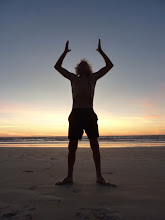"Remember
I am of the shore-line of contention where the waves meet the land. I
know the rising and falling tides of fortune, the ancient rhythms that
abide. I am of the coming and the going, of this realm and others. I
am the friend of the voyager of time."
"Pohutakawa, the Keeper of the Circle, the Tree of Life", Wisdom of the Four Winds, Barry Brailsford
"Pohutakawa, the Keeper of the Circle, the Tree of Life", Wisdom of the Four Winds, Barry Brailsford
TO SEE OVER 100 PHOTOS FROM THIS TRIP:
https://picasaweb.google.com/103250190528562753850/HARATAONGAGREATBARRIERISLANDNEWZEALANDMAY2012 To watch Liesbet's new short film "Mist Devas" go here:
http://youtu.be/_2bo0k7aUNg
https://picasaweb.google.com/103250190528562753850/HARATAONGAGREATBARRIERISLANDNEWZEALANDMAY2012 To watch Liesbet's new short film "Mist Devas" go here:
http://youtu.be/_2bo0k7aUNg
"HARATAONGA POHUTAKAWA ENCOUNTER"
Last week Liesbet and I went camping at a remote beach here on Great Barrier Island called Harataonga. We'd visited there several times over the years but this time we had received a special 'invitation' to venture to a more distant area, and we discovered THE most amazing ancient pohutakawa tree we've ever met. There was a perfect spot for our tent nestled right in the 'bosom' of the tree, too. It's hard to tell, but we guess this tree is at least 1000 years old.
"The bards have it that...the Yggdrasil tree's supernatural growth kept it constantly green, ever new, so that its heroic trunk bound Heaven to Earth and formed the imperishable structure of creation...The appropriateness of such an archetype for our planet is striking, for vegetation in quite a real sense does bind the sky to the Earth. Not only is vegetation the land's chief organ for absorbing rain that falls from the clouds and (after using it briefly) evaporating the same rain from its leaves back into the sky to maintain the terrestrial circulation, but vegetation quickens and conserves the entire atmosphere by inhaling excess carbon dioxide and exhaling vitalizing oxygen, the while holding up mountain ranges, stemming erosion with stems, rooting soil with roots, directing the courses of brooks and rivers and literally leashing stationary clouds to wooded slopes with invisible thongs of humid wind."
from 'Realm of the Vegetable', The Seven Mysteries of Life, Guy Murchie
This part of Great Barrier has some very interesting geological features as well, and isn't far from Hirakimata (Mt. Hobson), the island's highest peak and remnant of an ancient volcano.
Great Barrier Island in general is relatively undisrupted and undeveloped compared to most parts of mainland New Zealand, and the birds who were the original and only indigenous faunae of Aotearoa still abound and resound.
"In Queen Charlotte Sound on 17 January 1770, Joseph Banks, naturalist on James Cook's first expedition to the South Seas, caught a last vibration of primordial New Zealand - a land where bush grew to the water's edge and trees were filled from ground level to canopy with copious bird and insect life:
'This morn I was awakd by the singing of the birds ashore from whence we are distant not a quarter of a mile, the numbers of them were certainly very great who seemd to strain their throats with emulation...[Their] voieces were certainly the most melodious wild musick I have ever heard, almost imitating small bells but with the most tuneable silver sound imaginable.'
'For all its exuberance and beauty,' one of Banks' successors would write, '[that] dawn chorus was a mere echo of what could have been heard four hundred years before, for by 1770 around half of New Zealand's bird species were already extinct. Gone were the great booming calls of the moa (which we know about from their convoluted, bony tracheas), the screaming, mewing and cawing of a billion sea-birds (which even in Banks' day were banished from the main islands), adn the unknowable sounds of the native ducks, giant geese, and yard-high flightless rails, native crows, adn giant harriers...These creatures were gone, along with the flightless wrens and the giant eagles, because the first human inhabitants had carried with them to New Zealand rats and dogs, and the ability to hunt and to make fire."
from "A Land Without People", The Penguin History of New Zealand, Michael King
The power and beauty of wild New Zealand is immensely inspirational and is also a wonderful spiritual gift. The time, or should I say, timelessness, we spend here is both profound and unsettling; at the heart of it all dwell the mysteries of who and what we are as human beings, of where we find ourselves, and with whom else on Mother Earth.
For how much longer will humanity be able to carry on its present 'life-style'?
Can we learn to honour and respect our fellow beings, our planet, actually learn to 'live' in ways that are 'alive' before our non-human family is all gone, or before WE are gone, having left the Earth to those were truly intelligent.
JEFF PHILLIPS
NEW ZEALAND
MAY 2012



















